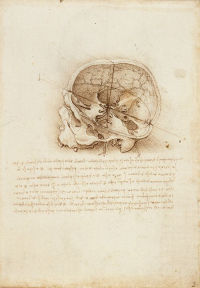The Body of Man Click on the thumbnails to explore the trail
Read more about this trail (expand)
According to Leonardo, man himself was at the centre of everything– “The measure of all things”. Throughout his life, the artist engaged in a dynamic and increasingly in-depth examination of man as a living organism, embarking on a seemingly unending quest to discover how man moved, grew, developed and perceived the world in which he lived.

- Enlarge
- The Royal Collection © 2005, Her Majesty Queen Elizabeth II
A skull sectioned 1489
One of the greatest challenges for Leonardo was understanding how the body functioned as a coherent entity.
According to medieval tradition, the brain contains three chambers that house the intellectual and imaginative faculties, the sensus communis and the memory. In addition to their receptive and analytical functions, these also perform the vital role of transmitting the commands for human motion and emotion. The sensus communis was supposed to be the site on which all of the nerves converged, and from which all voluntary action was controlled - everything from running, walking, or lifting an arm to small details of expression like smiling, or raising an eyebrow.
This is one of a series of studies of the human skull by Leonardo. The drawings are famous for their anatomical accuracy and the virtuosity of the pen and ink technique employed.
According to Leonardo, the sensus communis was also the locus of the human soul. Here, he plots the site of the sensus communis at the intersection of upright and diagonal lines seen within the tilted plane, at a point that marks the proportional centre of the skull.
In Leonardo's words
The soul seems to
reside in the judgement, and the judgement would seem to be seated in
that part where all the senses meet, called the sensus communis, and is
not all-pervading throughout the body, as many have thought. Rather it
is entirely in one part.
This is one of a series of studies of the human skull by Leonardo. Based on direct observation, the drawings are famous for their anatomical accuracy and the breathtaking virtuosity of the pen and ink technique employed.
In this meticulously observed side view of the sagittal section, Leonardo plots the site of the sensus communis, which he believed was the locus of the human soul, at the intersection of upright and diagonal lines seen within the tilted plane at a point that marks the proportional centre of the skull.
- Medium Pen and ink over light charcoal
- Size 19 x 13.7 cm
- Location The Royal Collection










